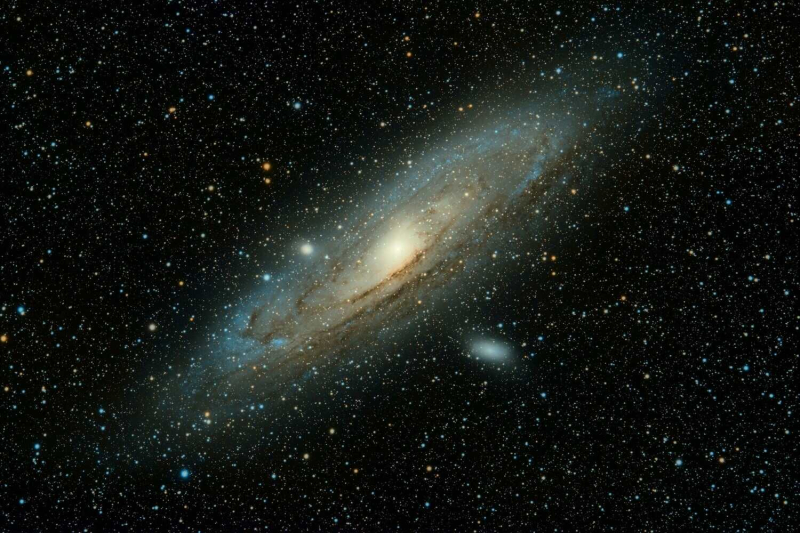
© Guillermo Ferla/Unsplash
For thousands of years, humanity has asked existential questions about the shape, first of the Earth, but also of our Universe. Obviously, the spherical aspect of our beautiful planet is now widely accepted, apart from a few “originals” shall we say, stuck before a few thousand years ago. Indeed, Greek philosophers and mathematicians like Pythagoras (5th century BC) and Parmenides (5th century BC) had already proposed the theory of a spherical planet.
On the other hand, it was not until the 16th century with the work of Nicolas Copernicus, Galileo Galilei and Isaac Newton that the entire scientific community finally accepted the idea that the Earth was indeed a sphere. However, even today, the shape of our Universe remains very mysterious. Recent research by the COMPACT (Collaboration for Observations, Models and Predictions of Anomalies and Cosmic Topology) group has revealed that our designs may still be too simplistic; the Universe could be much more complex than previously thought.
The illusion of cosmic simplicity
For a long time, scientists assumed that the universe had a relatively simple shape, like a three-dimensional sphere or flat surface. This hypothesis was based on the observation of the cosmic microwave background, a trace of the oldest light emitted approximately 300,000 years after the Big Bang.
Nevertheless, according to COMPACT cosmologists, this vision could well be erroneous. In truth, although we perceive our universe as homogeneous, subtleties could modify this uniform appearance. The Universe could possibly hide much more complex topological characteristics. For example, an object can share the same topology as another despite very dissimilar shapes; a cup of coffee and a donut share, in fact, a similar topological structure, because both have a single hole.
The discovery of these topological subtleties means that the& #8217;universe could be endowed with hidden structures, which are not immediately visible on large scales. Therefore, what appears to be a uniform three-dimensional space might actually be much more complex, with regions possessing distinct geometric properties. Enough to make you even more dizzy.
Cosmic loops
Topology, the branch of mathematics dedicated to the study of the properties of geometric spaces, plays a key role in understanding the shape of the Universe. Scientists use this discipline to classify shapes according to their characteristics, in particular the hypothetical presence of holes or loops in our Universe. These loops could theoretically send light back to its starting point after a long journey through space.
If our universe took the shape of a torus (donut ), for example, a light beam could return to its point of origin. Just like an ant would move on a donut and return to its starting point after traveling in a loop.
Despite intensive searches in the early 2000s, experts had failed to detect such loops in the cosmic microwave background data. This lack of evidence led many cosmologists to conclude that the universe therefore had a relatively simple structure. However, the new COMPACT analyses suggest that these loops may be larger than current observations can detect, or that the universe may contain copies of itself in slightly modified forms, making their detection more difficult. You are still following ?
A never-ending quest ?
COMPACT has compared the most recent data acquired about the cosmic microwave background with various topologies of the universe and the results are most astonishing. They have, in fact, revealed that previously neglected shapes could correspond to those of our cosmos. In total, they managed to identify 18 different categories of flat three-dimensional surfaces, each of which could potentially represent the shape of our Universe.
Among these, we can cite an ordinary torus, as well as two variants of it, with twist. To make a classic torus, imagine that you take a sheet of paper that you fold on itself and stick it together at opposite edges. This will form a tube. Then bend this tube so that its ends meet and glue them together again. This creates a looped shape, similar to a three-dimensional donut.
For the variants with twist, it gets a little more complicated. Take that same sheet of paper and, before gluing opposite edges together to form the tube, give it a little twist. The latter will then create a more complex shape where the paths inside are modified by this tendril, making the space more complicated.
These discoveries suggest that our understanding of the Universe is far from complete and that we have not yet fully understood how it was formed. The idea that the latter could be a flat surface like a sheet of paper or a three-dimensional sphere may well be a thing of the past. New models will therefore have to be explored in order to fully grasp the cosmic topology, because understanding it could reveal essential data to us on the quantum processes that took place just after the Big Bang. In any case, the COMPACT group has opened quite a Pandora's box.
- Research carried out by a group of scientists (COMPACT) suggests that the Universe could have a much more complex shape than previously thought.
- They put the principle of cosmic loops, abandoned at the beginning of the 2000s, back at the center of the scientific debate.
- They succeeded in identifying 18 categories of different shapes that would be theoretically viable.
📍 To not miss any news from Presse-citron, follow us on Google News and WhatsApp.
[ ]

